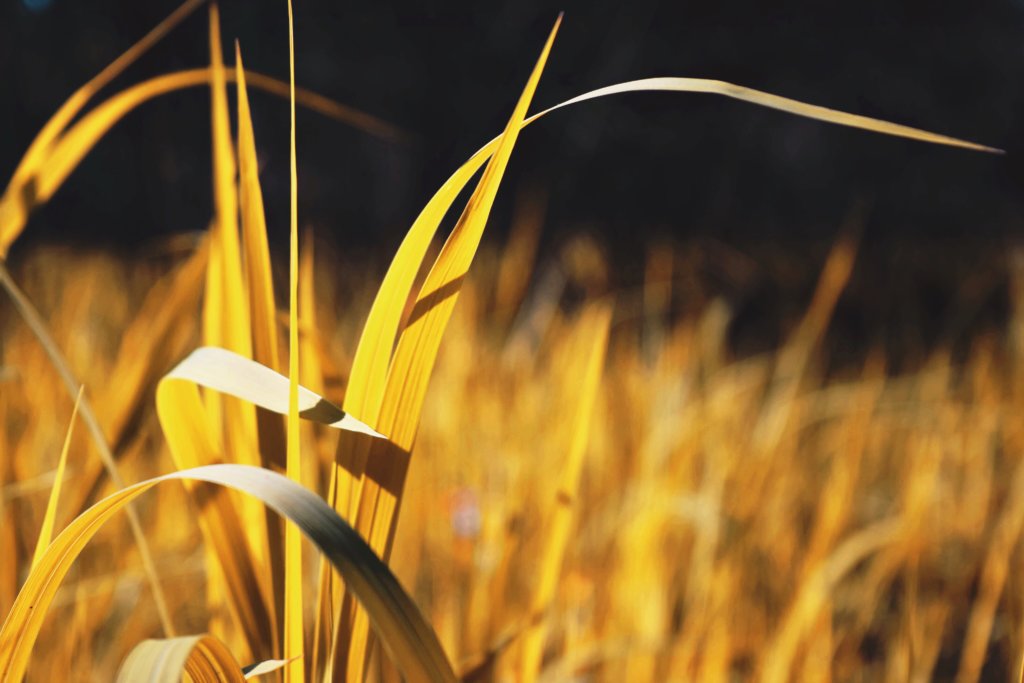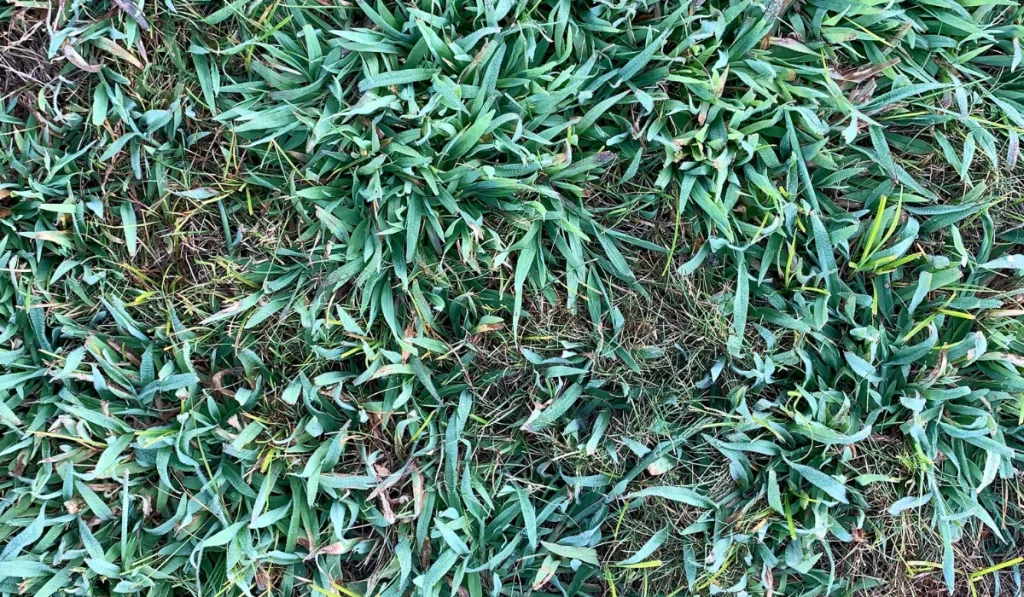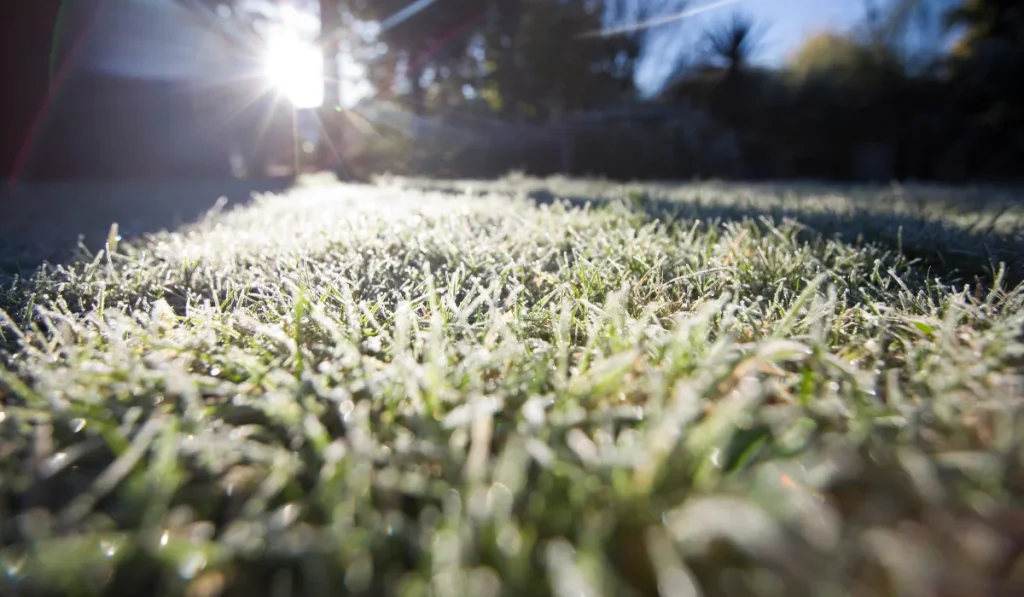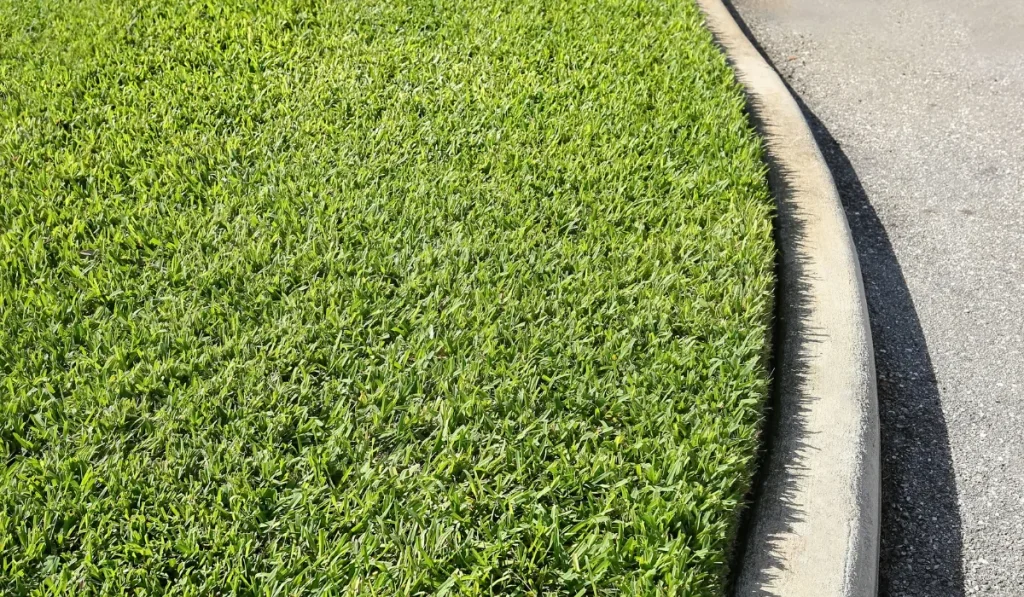You’ve spent hours watering, seeding, weeding, and fertilizing. You know your irrigation schedule like the back of your hand. So despite all of your hard work, you might find yourself wondering (with a fair deal of frustration, we might add!), “Why is my grass turning yellow?”
There are several reasons your grass might be turning yellow, but before you can fix the problem, you need to identify it. That sounds obvious – but it can be tricky to narrow down potential issues so that you can take the appropriate steps.
Don’t worry – we’ve got your back. In this post, we’ll cover the most common causes of yellow grass and how to address them. Keep reading to learn more!
Key Takeaways
- The most common causes of the problem are pet urine, nutrient deficiencies, and watering problems, but diseases, mowing issues, and soil compaction can also be culprits.
- Improving drainage and adjusting your watering schedule is the first step you should take.
- If yellow spots are severe or widespread, you may need to reseed or put down new sod.
Common Causes of Yellow Spots on Lawns
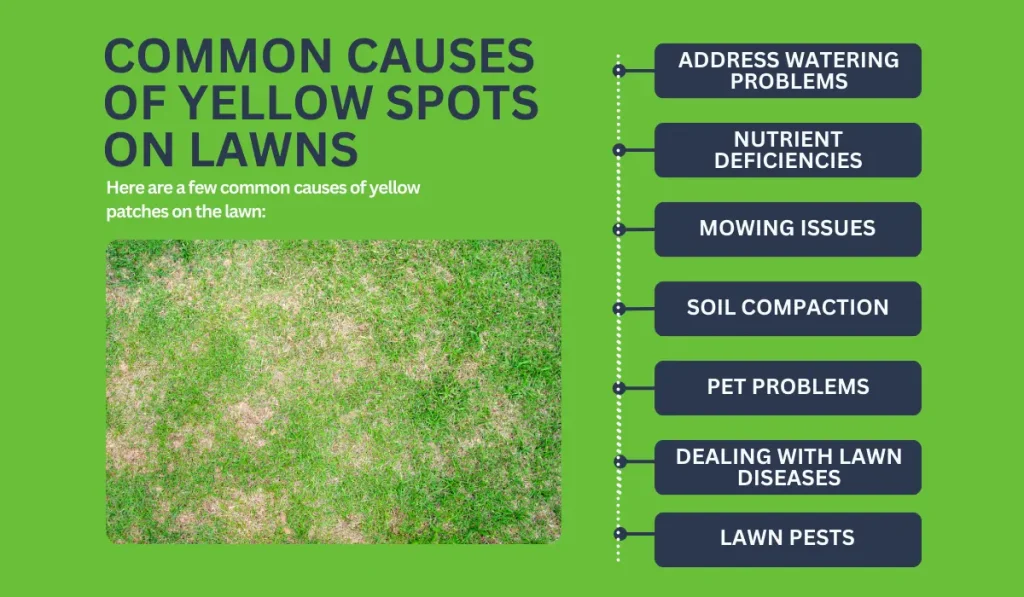
Here are a few common causes of yellow patches on the lawn – as well as some actionable solutions to try.
Address Watering Problems
Too much water – or too little water – can both be problematic for your lawn. Underwatering is the most common reason for yellow spots on the lawn, particularly during periods of hot weather.
In general, your lawn needs about an inch of water per week, applied at regular intervals, so it goes deep into the soil and doesn’t just pool on top of the soil surface.
Extreme heat and areas exposed to the sun all day dry out more quickly, with the heat stressing the lawn and causing yellow areas. You’ll know this is the issue if the spots are not only yellow but dry and crunchy. Water more frequently – and deeply – to rectify the problem.
See if you can find ways to increase air circulation to the grass’s roots and improve drainage in your lawn. Both of these steps will help make your irrigation efforts more effective since the water will be going exactly where it needs to be.
Remember, if your plants aren’t getting enough water, none of the other steps listed below will be very effective at correcting a yellow lawn.
Nutrient Deficiencies
A lack of nutrients could also be to blame for the yellowing of your grass blades. Remember, grass blades need nitrogen to grow green and strong – without the right kind of fertilizer, they’re going to start looking a bit lackluster!
Too much nitrogen can also be to blame – usually, this is from too much fertilizer. While nitrogen is the most important nutrient for a healthy lawn, too much can burn grass roots and alter the pH of the soil. In turn, this creates issues with the ability of the roots to take up the water and nutrients they need.
It’s not just nitrogen that your grass needs – make sure you are administering a balanced fertilizer formulated specifically for the exact type of lawn you are trying to grow. When you fertilize, always water it in deeply, too. That’s true even if you’re just applying a top dressing of fertilizer – this can prevent fertilizer burn and make sure the fertilizer is evenly distributed.
In some cases, it could be an iron deficiency to blame. It’s always a good idea to do a soil test to figure out why your green grass isn’t quite so green – but iron, second only to nitrogen, is one of the most common deficiencies for lawns.
Fertilize as recommended for your grass type – and watch out for weed competitors who will sap the resources from the fertilizers you’re trying to give your grass. Try not to fertilize when your grass is already suffering from heat stress, as the dryness will overtax your plants and prevent the fertilizer from getting to where it needs to go.
Mowing Issues
Take a close look at your patterns with the lawnmower to see if that’s what’s causing yellow lawn patches on the ground.
Are you mowing your lawn when it’s still damp after heavy rain or irrigation? Try to mow only when the grass is dry and when the blades are nice and sharp. Be sure to mow at the proper height for your specific type of grass.
After mowing, dispose of the clippings rather than leaving them on the lawn. Although clippings can sometimes provide the right amount of fertilizer to your plants, helping you produce a nice, green lawn, they can also suffocate underlying grass plants and ultimately inhibit their growth, particularly in cooler temperatures.
Soil Compaction
Soil compaction is another common issue that can damage your grass. Though this is one of the least possible causes if you have sandy soil, if your soil is on more of the clay side or if you have areas of your lawn that are subjected to frequent traffic – like places you drive on or where the kids tend to play – soil compaction could be to blame.
You can suspect this issue if you notice excess water pooling after irrigation. That indicates that the right amount of water isn’t getting down into the roots of the turf in the most effective way.
You can clear this issue up by aerating and dethatching, which should open up space in the soil for water to penetrate.
Pet Problems
Do you have a dog? If so, dog urine could be what’s discoloring your lawn.
Dog urine is especially high in nitrogen – if you recall us telling you about the common problems with excess nitrogen earlier in this article, you know that too much nitrogen is a no-no. And just because dog urine is a bit more “natural” than the synthetic fertilizers you might be using on your lawn, that doesn’t mean that you can allow Fido to go crazy out there!
If dog urine is to blame, you’ll notice yellow spots bordered by greener grass – the diluted edges of the area sprayed by urine are fertilizing and feeding your grass, but the concentrated center (where most of the urine is being deposited) is burning the roots.
Dealing with Lawn Diseases
If you notice a large area of your lawn afflicted by yellow patches, it could be a disease to blame. Diseases aren’t the first issue you should investigate when you have yellow patches, but they can still be blamed.
In most situations, it will be a fungal disease to blame.
The most common diseases that affect lawns are:
- Snow mold
- Fairy rings
- Smut
- Fusarium
Fungal infections almost always tend to be related to moisture. Check your watering schedule to see if you’re overwatering your lawn, particularly the sections that are in the shade.
Also, get thatching and aerating on your schedule. This helps open up more space in the lawn for oxygen and moisture to penetrate – meaning fungal spores won’t have much of a fighting chance.
You may also want to check that you’re mowing your lawn properly. Leaving clippings on the lawn can encourage the development of diseases like snow mold in the early spring.
Lawn Pests
Last but not least, there are a few lawn pests that might be to blame for your discolored blades. The best way to prevent moth pests responsible for making your grass yellow is to maintain a healthy lawn through the steps described above.
However, sometimes even the best preventative efforts don’t fully prevent all pests, and you’ll need to get down on your hands and knees with a magnifying glass and become a lawn Sherlock Holmes.
If you see any small insects or larvae feeding on the roots of the grass, it’s likely a pest, like chinch bugs or chafer grubs. In most instances, it’s insect larvae that eat the grass roots rather than adults. You’ll need to get rid of the larvae when they’re still young.
You can apply an insecticide (choose one that’s formulated specifically for the exact kind of pest you’ve identified) now to get rid of them. Then evaluate your lawn care practices afterward to prevent pests from being drawn to your lawn in the future.
How to Green Up a Yellowing Lawn
If you’ve tried all the solutions listed above and still aren’t having much luck, it might be time to remove and replant the patches that turned yellow. This is a good idea if the yellowing lawn was caused by physical damage – like some scorching from a heat source (such as a grill) or a chemical spill.
Simply add fresh soil and compost to the bare patch before laying down new sod or reseeding. It’s as simple as that.
If you’re like most homeowners, then you take great pride in your lawn. After all, a well-manicured yard is the perfect finishing touch to any home. So when you start to see your grass turning yellow, it’s only natural to be concerned. But don’t worry – there are plenty of things you can do to get your lawn back to its former glory.
Follow these tips and give your lawn the proper care, and you’ll be able to take your yucky yellow lawn to a lush green lawn in no time!
